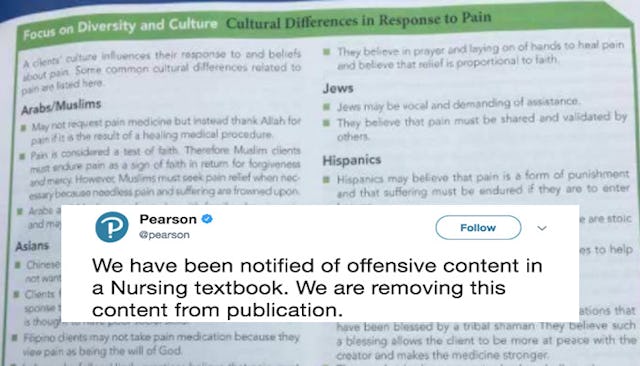Nursing Textbook Offers Racist Advice On How Different Cultures Handle Pain

Textbook company removes content from publication
If you’ve been out of school for a while, you might think that today’s textbooks are more or less free of blatant racism. Well, bad news, friends. A Facebook post about a nursing textbook published in 2014 shows how racism couched as cultural sensitivity is still very much at play in at least one particular, surprising area: pain management in healthcare.
Onyx Moore tells Scary Mommy that last week, she came across a photo in her newsfeed that got her attention. It was a page from a nursing textbook titled Nursing: A Concept-Based Approach to Learning. In a chapter on acute and chronic pain, the book had a sidebar detailing how different cultures respond to pain. Hang on to your giblets, folks, because it’s every bit as awful as you think:
The inclusion of a sidebar called, “Focus on Diversity and Culture” in a nursing textbook should raise alarm bells immediately. If the viewpoints of different cultures are included as a “p.s.” then it’s clear who the rest of the book is written for, isn’t it? You’ll also notice that somehow the reactions of white people to pain were omitted from this section. Coincidence? Oversight? No, and nope.
Among the remarkably awful tidbits in this section are the following:
- “Muslim clients may endure pain as a sign of faith in return for forgiveness and mercy.”
- “Clients from Asian cultures often value stoicism…a client who complains openly about pain is thought to have poor social skills.”
- “Blacks often report higher pain intensity than other cultures…They believe in prayer and laying on of hands to heal pain…”
- “Jews may be vocal and demanding of assistance.”
- “Hispanics vary widely in their expression of pain: Some are stoic and some are expressive.”
- “Native Americans…usually tolerate a high level of pain without requesting pain medication.”
Holy…effing…balls.
Understandably, both Twitter and Facebook users had thoughts on this picture. But Moore’s post has gone viral because of her clear and on-point explanations of why this content is so troubling.
“These assumptions are not evidence-based,” she writes. “…They encourage nurses to ignore what a patient is actually saying (if someone tells you their pain level is high, you need to believe them), they list common behaviors as culturally specific (most people are more comfortable being honest about their pain with family members/those close to them), and they don’t actually teach nurses how to engage in a CULTURALLY SENSITIVE way.”
The only person who thinks it’s culturally sensitive to write off the pain of a Jewish patient because they read in a book that “Jews may be vocal and demanding of assistance” is someone who’s uneducated and willing to let their patients suffer because it’s easier to paint them with a broad brush. That’s not only racist and ignorant, it’s also inhumane and possibly life-threatening.
Moore continues by laying out exactly how these broad assumptions are both incorrect and inadequate: “This chart lumps together various groups whose belief-systems vary widely. Native Americans are not a monolithic group, so you can’t make a generic list of what is culturally sensitive to them. Asia is a huge continent and the chart completely glosses over that while leaving out countless groups in an attempt to convey the message quickly. If they are including African people under Black, then they’re intentionally shoving together a whole host of groups with different cultural customs; if they’re not including them under Black, then they just completely ignored an entire portion of patients. Jewish/Muslim can be both ethnicities or religions, so what happens if a Black Jew comes in? Or a Black Muslim?”
Pearson, the maker of the textbook, has responded to the controversy on Twitter:
It’s important to point out that this didn’t start with a page in a nursing textbook. Numerous studies have found that black people are regularly under-treated for their pain in emergency rooms and other medical settings. Recent research into why that is has found that many people — including medical personnel — believe there are biological differences between black people and white people that cause them to treat their pain differently. A study just last year from the University of Virginia found that: “a substantial number of white medical students and residents hold false beliefs about biological differences between black and white people (e.g., black people’s skin is thicker; black people’s blood coagulates more quickly)….”
The fact that the solution to this problem is so simple (ask people about their pain and treat them accordingly) and yet there are still a large number of patients of color who are not receiving adequate pain management is, quite frankly, disgusting. Moore, of course, put the answer simply and perfectly in her post: “If you want to be culturally sensitive, then you need to actually LEARN about other cultures. If a patient tells you their pain level, believe them- because they are the expert on their body. As a medical professional, your job is to provide medical care, the patient’s job is to convey their symptoms; when in doubt err on the side of better treatment, not disbelief.”
This article was originally published on